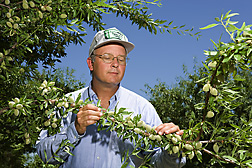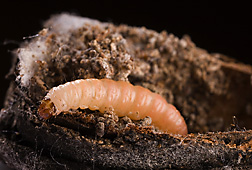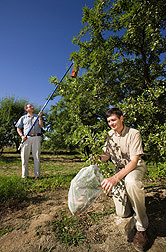Self-Pollinating Almonds
Key to Bountiful Harvests
|
|
California has more than 600,000 acres of almond orchards. At the beginning of each new year, these almond trees burst into bloom. That’s when growers will need many millions of robust bees to ferry pollen from one cream-white blossom to the next.
Hive-rental costs to almond growers are high, ranging from $125 to $180 per hive. But in the future, these costs may be avoidable because bees may no longer be needed for almond pollinating.
This possibility could prove true as a result of the work of Agricultural Research Service geneticist Craig Ledbetter, in the Crop Diseases, Pests, and Genetics Research Unit in Parlier, California. He has developed new and improved self-pollinating almond trees—ones that can produce a bountiful harvest without being pollinated by insects.
|
|
Self-pollinating almonds are not new. The Tuono variety, originally from Spain, has been around for centuries. But it has few of the characteristics that have made California almonds beloved domestically and internationally. Almond breeders will tell you that Tuono is simply not as attractive as California’s most popular almond, Nonpareil, because Tuono has a hairy texture to the seed coat.
“You can feel that hairiness with your tongue,” says Ledbetter. “That can turn off U.S. almond consumers, who are used to the smooth texture of Nonpareils.”
Another strike against Tuono—it has a very thick, hard shell, so only 32 percent of the nut is edible kernel. Nonpareil, however, is 60 to 65 percent kernel.
One good thing about Tuono’s thick shell is that it gives the nut more resistance to the dreaded navel orangeworm, the primary pest of almonds in California. At Parlier, an areawide integrated pest management program is under way to reduce navel orangeworm damage and broad-spectrum insecticide use throughout the San Joaquin Valley. The program is being led by Joel Siegel, assisted by fellow entomologists Bas Kuenen and Chuck Burks.
|
|
Eight Great Almond Selections
Though both Tuono and Nonpareil almonds have their strong points, the ideal almond would have the best traits of each. In 1993, Ledbetter started his work to breed a desirable self-pollinating almond. Seedlings were first planted in 1996 and every year thereafter.
Tuono was used as the male (pollen) parent in conventional hybridizations with California-adapted almond cultivars and selections. Ledbetter and his team made the crosses at bloom time and came back at harvest time to collect the nuts. The scientists grew out those nuts into seedlings and then surrounded the branches with insect-proof nylon bags to exclude insects that could serve as pollinators. The seedlings bloomed, and some produced fruits inside the bags. The scientists knew that these seedlings were the self-pollinators, because no foreign pollen had been introduced into the bags.
At first, harvests from the seedlings were small, but by 2006 the trees began producing excellent harvests. In November 2008, after a very good fall almond harvest, Ledbetter and his Parlier team brought eight very promising self-pollinating selections to the California Almond Board for evaluation of taste and appearance. The testers were pleased with the skin color, oil content, and—most importantly—the flavor. The new almonds have many of the same characteristics of Nonpareil, which has been grown in California since the 1880s and accounts for 37 percent of all almonds grown in the state.
“What separates the Parlier-developed selections and Nonpareil, of course, is that these ARS almond trees need no external pollination,” said Ledbetter. “Ours is a very good-looking kernel that’s very comparable to that seen in Nonpareil.”
Shells Snare Chemicals From Water
In other work, Ledbetter is working with Thomas Klasson, research leader at ARS’s Commodity Research Unit in New Orleans, Louisiana, to test the adsorption ability of almond shells. Parlier is near Fresno, and as in many other cities, there are concerns about water quality. In Fresno’s case, those concerns date back to World War II, when chemicals from cleaning military aircraft from the city’s air base entered the groundwater supply. Use of agricultural nematicides—chemical pesticides used to kill parasitic nematodes—in orchards and vineyards around Fresno for many decades has also harmed water quality in the area’s aquifer.
To purify this water, granular activated carbons (GACs) were put to use to adsorb the chemicals. Fresno has 35 GAC sites alone, each using a minimum of 20,000 pounds of granulated carbon.
In California, more than 1.3 billion pounds of almond meat is produced every year, but much of the almond shells from those nuts goes to waste. Ledbetter and Klasson have been working together for the past 2 years to see whether this mass of almond-shell carbon could be used in these mammoth municipal city GAC vessels. In laboratory testing, almond-shell carbons have proven to have high adsorption ability. Testing in a larger vessel will be done in the upcoming years.—By Alfredo Flores, Agricultural Research Service Information Staff.
This research is part of Plant Genetic Resources, Genomics, and Genetic Improvement, an ARS national program (#301) described at www.nps.ars.usda.gov.
Craig A. Ledbetter is in the USDA-ARS Crop Diseases, Pests, and Genetics Research Unit, 9611 S. Riverbend Ave., Parlier, CA 93648; (559) 596-2817.
"Self-Pollinating Almonds Key to Bountiful Harvests" was published in the April 2010 issue of Agricultural Research magazine.










